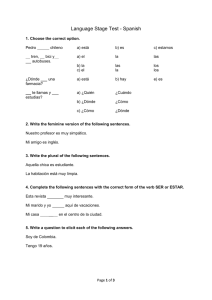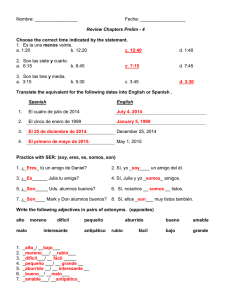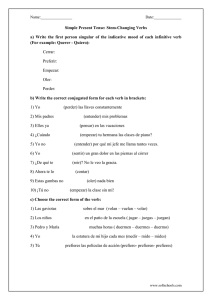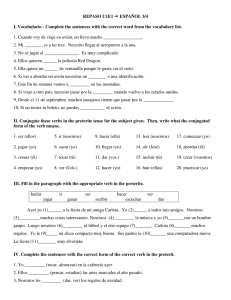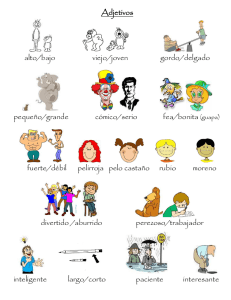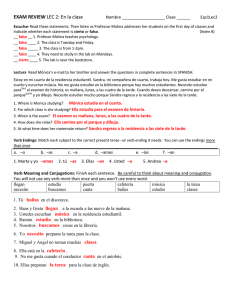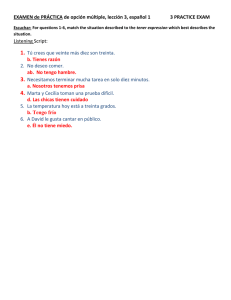1 Avancemos, Level 1 Spanish 1 – Semester 1 Semester Review
Anuncio
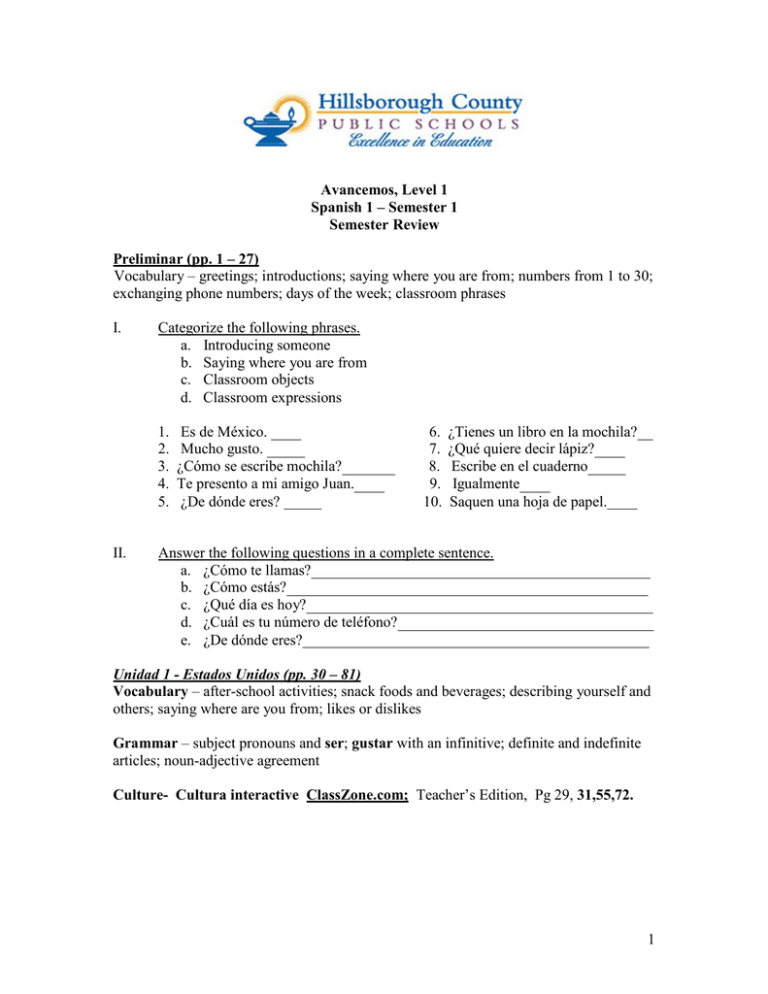
Avancemos, Level 1 Spanish 1 – Semester 1 Semester Review Preliminar (pp. 1 – 27) Vocabulary – greetings; introductions; saying where you are from; numbers from 1 to 30; exchanging phone numbers; days of the week; classroom phrases I. Categorize the following phrases. a. Introducing someone b. Saying where you are from c. Classroom objects d. Classroom expressions 1. 2. 3. 4. 5. II. Es de México. Mucho gusto. ¿Cómo se escribe mochila? Te presento a mi amigo Juan. ¿De dónde eres? 6. 7. 8. 9. 10. ¿Tienes un libro en la mochila? ¿Qué quiere decir lápiz? Escribe en el cuaderno Igualmente Saquen una hoja de papel. Answer the following questions in a complete sentence. a. ¿Cómo te llamas? b. ¿Cómo estás? c. ¿Qué día es hoy? d. ¿Cuál es tu número de teléfono? e. ¿De dónde eres? Unidad 1 - Estados Unidos (pp. 30 – 81) Vocabulary – after-school activities; snack foods and beverages; describing yourself and others; saying where are you from; likes or dislikes Grammar – subject pronouns and ser; gustar with an infinitive; definite and indefinite articles; noun-adjective agreement Culture- Cultura interactive ClassZone.com; Teacher’s Edition, Pg 29, 31,55,72. 1 I. Categorize the following activities (More than one may apply.) A. activities normally done at school B. activities normally done at home C. activities normally done outside 1. 2. 3. 4. 5. 6. 7. andar en patinetaescuchar músicapreparar la comidahacer la tareajugar al fútbolleer y escribiraprender el español-_ II. Vocabulary Review List three things that you like to drink 1. 2. 3. List three things that you like to eat. 1. 2. 3. II. Answer the following questions in a complete sentence. 1. ¿Qué te gusta hacer? (list several things!) 2. ¿Qué no te gusta hacer? 3. ¿Te gusta pasear después de las clases? 4. ¿Cómo eres? (use several descriptions) 5. ¿Cómo es tu mejor amigo/a? III. Fill in the one of the following subject pronouns that corresponds with the verb: 1. 2. 3. 4. a. Ellos, b. Ella, c. Tú, d. Nosotros. eres estudiante. es de Perú. somos de Colombia. son de México. 2 IV. Fill in the correct form of the verb ser. 1. 2. 3. 4. 5. V. Fill in the correct form of the verb gustar and the corresponding pronoun. a. me gusta, b. te gusta, c. le gusta, d. nos gusta, e. les gusta 1. 2. 3. 4. VI. A ti comprar fruta. ¿A Ud. alquilar un DVD? A mi pasar un rato con amigos. comer pizza. A mis amigos Write the opposite of the following adjectives. 1. 2. 3. 4. 5. 6. 7. 8. VII. a. eres b. son c. soy d. somos e. es Uds. de Puerto Rico. Tú no de Guatemala. Paco y yo de Los Angeles. Claudia simpática Yo inteligente alto bueno trabajador organizado cómico pequeño joven feo _ _ Write the correct definite AND indefinite articles for the following nouns. Ex: el / un chico (the / a boy) 1. 2. 3. 4. 5. 6. / / / / / / hombre persona amigos papas fritas actividad agua 3 VIII. Translate the following noun phrases. (Watch word order!) 1. 2. 3. 4. 5. 6. the intelligent students (m.) a nice lady good fruit a large ice cream He has a red hair_ She is tall and blonde Unidad 2.1,2 - Mexico (pp.84-129) Vocabulary – daily schedules; telling time; numbers from 11 – 100; classroom objects, describing classes; describe frequency; describing location; expressing feeling. Grammar– the verb tener; present tense of –ar verbs; the verb estar; the verb ir Culture- Cultura interactive ClassZone.com; Teacher’s Edition, Pg. 83, 84,85,116, 122. I. Answer the following questions in a complete sentence. 1. ¿Qué hora es? 2. ¿A qué hora vas a la escuela? 3. ¿Qué clases tienes? 4. Translate into English: II. a. Temprano b. De la noche c. De la manana d. De la tarde Categorize the following phrases. a. biblioteca b. papel c. enojado_ d. 1. what you might find in a mochila - 2. places in a school 3. describing how you might feel lápiz 4 e. ocupado_ f. gimnasio IX. Fill in the correct form of the verb tener. 1. ¿Cuántas clases tú? 2. Yo que contestar muchas preguntas. 3. Pablo y Claudia no la clase de arte. X. Fill in the correct form of the verb estar. 1. 2. 3. 4. XI. Uds. enojadas. El escritorio cerca de la ventana. ¿Dónde la cafeteria? ¿Cómo tú? Fill in the correct form of the verbs given. 1. 2. 3. 4. XII. 1. 2. 3. 4. Los estudiantes las preguntas. (contestar) El maestro historia. (enseñar) Elena y yo _ buenas notas. (sacar) Yo tarde a la clase. (llegar) Fill in the correct form of the verb ir. Mis amigos y yo _ a la biblioteca. ¿Adónde tú ahora? Carlos no al gimnasio. Está cansado. a mi clase de matemáticas. Tengo que Unidad 3.1 - Puerto Rico "Comer en Familia"(pp. 140 – 159) Vocabuly – food and beverages; ask questions; giving dates; say which food you like and don’t like Grammar– gustar with nouns; interrogative words; present tense of –er and –ir nouns the verb hacer Culture- Cultura interactive ClassZone.com; Teacher’s Edition, Pg. 136,137,139. 5 I. Categorize the following words. a. algo de comer 1. 2. 3. 4. 5. 6. 7. b. algo de beber jamón jugo de naranja leche huevo manzana uvas café II. Answer the following questions in a complete sentence. 1. ¿Qué te gusta más, una hamburguesa o un sándwich de jamón y queso? 2. ¿Cuál es tu comida favorita? 3. ¿Cuántas clases tienes? 4. ¿Quién es tu profesora de ciencias? 5. ¿Por qué no vas al restaurante? III. Fill in the correct form of the verb gustar. (pg.145) 1. A los estudiantes les el fútbol. 2. A Carlos no le los jugos. 3. A mi mamá y a mí nos comprar ropa. 4. ¿Te las uvas? IV. Fill in the correct form of the verb given. 1. Yo un libro. (leer) 2. Tú el español. (aprender) 3. Uds. en el pizarrón. (escribir) 4. Tú y yo una pizza. (compartir) Buena Suerte!!!!!!!! 6
